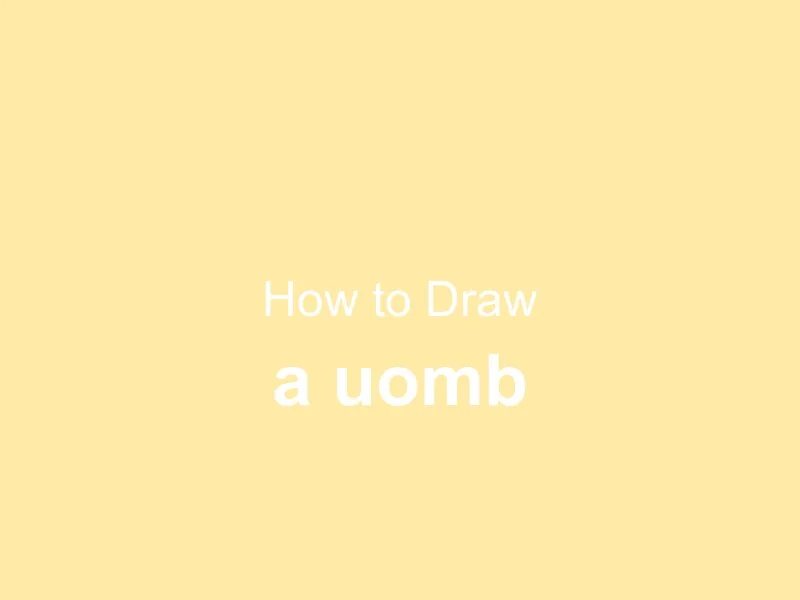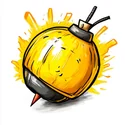How to Draw a Bomb
Learn how to draw a bomb with this step-by-step guide.

Materials You'll Need
- Drawing paper
- Pencil (HB or 2B)
- Eraser

The classic cartoon bomb—round, bold, and topped with a fizzing fuse—has become an instantly recognizable symbol in art, animation, and pop culture. Whether you've seen it in vintage comic strips, video games, or animated movies, this iconic image always grabs attention and brings a dynamic, playful energy to any scene. Learning how to draw a bomb can be both fun and educational, offering a great opportunity to practice simple shapes, symmetry, and shading techniques. It's also a perfect subject for adding your own creative twists, like expressive faces or dramatic sparks, making it popular for both beginners and more experienced artists looking to refine their illustration skills.
There are many reasons why you might want to learn how to draw a bomb—perhaps you're designing a comic panel, creating themed artwork, or just want to expand your repertoire of classic cartoon objects. The process involves mastering basic geometric forms, specifically drawing smooth circles and cylinders, as well as experimenting with highlights and shadows to give your bomb a three-dimensional, polished look. This tutorial is designed with artists of all skill levels in mind, breaking down each step so you can follow along easily, even if you're a complete beginner. By the end, you'll have a bold, dynamic drawing and a better understanding of essential drawing techniques.
So, if you've ever wondered how to draw a bomb that looks both classic and full of character, you're in the right place! Grab your favorite drawing materials, set aside a little creative time, and remember—practice makes perfect. With each step, you'll not only build your confidence but also add a new, explosive element to your artistic toolkit. Let's get started and see where your imagination takes you!
Materials Required:
-
Black pen or marker (optional)
-
Coloring materials (optional)
Now that we have our materials ready, let's begin creating our bomb drawing.
Step 1: Sketch the Basic Shape
Start by drawing a large oval shape in the center of your paper. This oval will serve as the main body of the bomb. Take your time to ensure the shape is symmetrical and proportionate.
Step 2: Add the Fuse
At the top of the oval, sketch a small rectangle shape vertically. This will represent the fuse of the bomb. You can choose to make it short or long, depending on your preference.
Step 3: Define the Shell
Around the oval shape, draw a slightly irregular, jagged line to represent the outer shell of the bomb. This will give it a more realistic and explosive appearance. Use quick, light strokes to create the jagged edges.
Step 4: Detail the Fuse
Now it's time to add some detail to the fuse. Draw a circle or oval shape at the end of the fuse to give it a burned look. You can also add a thin, curved line near the base of the fuse to create a more realistic texture.
Step 5: Draw the Metal Bands
To make our bomb drawing look more authentic, we need to add some metal bands around the body. Draw a horizontal line across the oval, slightly below the middle. Then, sketch two diagonal lines that intersect the horizontal line, creating a band across the bomb. Repeat this step to add more bands, depending on the level of detail you desire.
Step 6: Add the Ignition Button
At the bottom of the bomb, draw a small circle or rectangle to represent the ignition button. This button is usually red or black and adds to the overall visual appeal of the bomb.
Step 7: Erase Unnecessary Lines
Take your eraser and carefully remove any unnecessary guidelines or construction lines. This will help clean up your drawing and make it look more polished.
Step 8: Ink the Drawing (optional)
If you prefer a more defined and bold look, you can use a black pen or marker to trace over the pencil lines. Be sure to let the ink dry completely before erasing any remaining pencil marks.
Step 9: Color Your Drawing (optional)
Now comes the fun part – coloring! Use your preferred coloring materials to bring your bomb drawing to life. You can opt for realistic colors or get creative and add your own unique twist.
Tip: To create a striking cartoon bomb, start with a perfect circle as your base; using a compass or a round object can help achieve a smooth, even shape. Once you have your circle, sketch a slightly tapered cylinder on top to form the fuse holder, ensuring it aligns symmetrically with the bomb's body. For the fuse, draw a wavy line that extends upward, and add some flickering sparks at the tip for dynamism. When shading, use a soft pencil or blending stump to create a gradient that gives the bomb a rounded look—darker on one side and lighter on the opposite to simulate light reflecting off its surface. Finally, don't forget to add any personal touches, like a cheeky face or vibrant colors, to make your bomb uniquely yours!
Conclusion
Drawing a bomb might seem like a challenging task, but by following these step-by-step instructions, you can create an explosive masterpiece. Remember to start with the basic shape, add details such as the fuse, shell, metal bands, and ignition button, and finally, ink and color your drawing if desired. With practice, you'll be able to create realistic and captivating bomb drawings in no time.
So, grab your pencil and let your creativity detonate as you draw your own bomb masterpiece!
Fun Facts About Bomb
-
The classic cartoon bomb design, with a round black body and a fizzing fuse, became popular through early animation studios like Warner Bros..
-
The word bomb comes from the Greek word "bombos," which imitates the sound of a deep, booming noise.
-
Early bombs were made using gunpowder, first invented in 9th-century China.
-
Bombs have been used in art and pop culture as symbols of danger, excitement, or surprise, as discussed by TV Tropes.
-
The iconic bomb with a fuse is rarely seen in real life; most modern explosives use electronic detonators.
-
In video games like the "Super Mario" series, bombs (often called Bob-ombs) are popular enemies and power-ups.
-
Bomb disposal experts, known as EOD technicians, use specialized robots to safely defuse explosives.
-
The largest bomb ever detonated was the Tsar Bomba, tested by the Soviet Union in 1961.
Suggestions for Scenes and Settings for Bomb Drawings
-
Cartoon Bank Heist: Draw a mischievous cartoon character about to use a classic round bomb to blow open a safe in a bustling cityscape bank.
-
Mad Scientist's Lab: Illustrate a zany inventor surrounded by blueprints, test tubes, and a table full of quirky cartoon bombs with fizzing fuses.
-
Video Game Power-Up: Depict a bomb as a collectible power-up in a side-scrolling platform game, glowing with energy.
-
Animated Bomb Parade: Create a festive scene where animated bombs march in a parade, each with unique faces and personalities.
-
Superhero Showdown: Show a superhero racing to disarm a ticking cartoon bomb before time runs out in a dramatic cityscape.
-
Classic Comic Strip: Draw a slapstick moment where a bomb comically malfunctions, producing only a harmless puff of smoke and a surprised character.
-
Firework Festival: Illustrate a nighttime festival where cartoon bombs explode into colorful, playful fireworks in the sky.
-
Deserted Pirate Island: Depict a treasure-hunting pirate using a bomb to uncover hidden loot among palm trees and treasure chests.
-
Monster's Workshop: Show a goofy monster tinkering with various cartoon bombs in a cluttered, imaginative workshop.